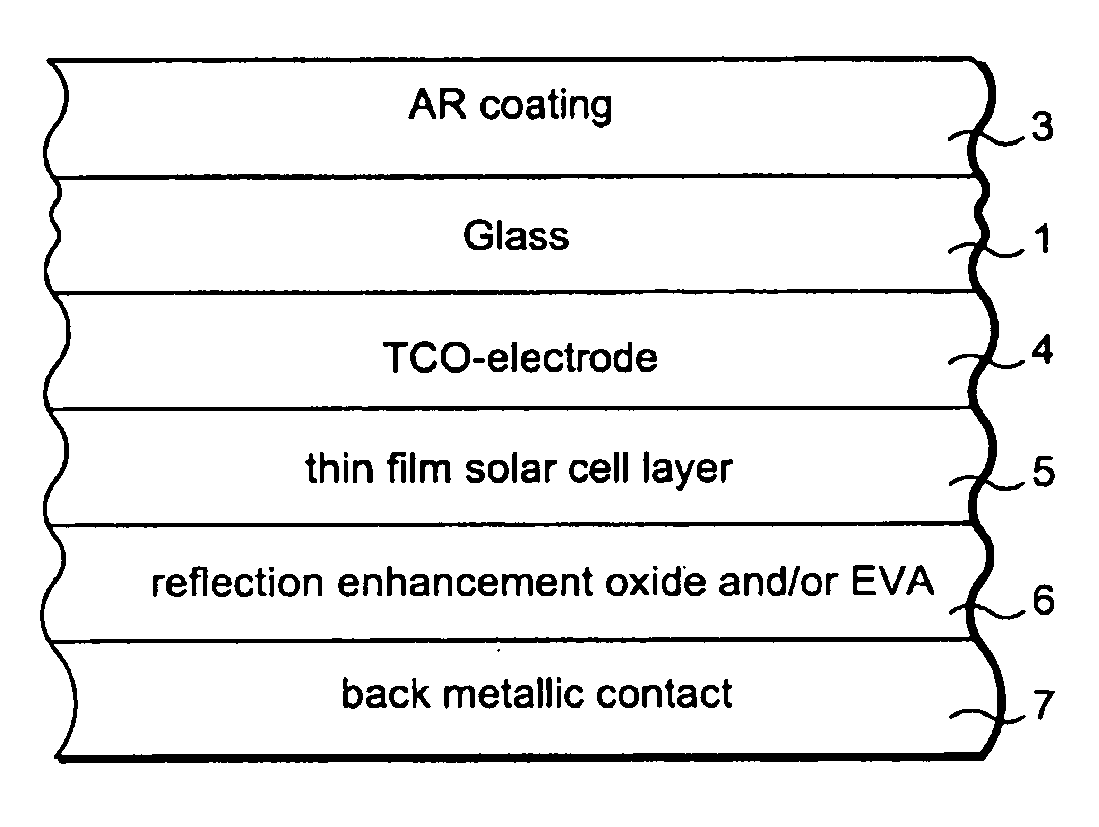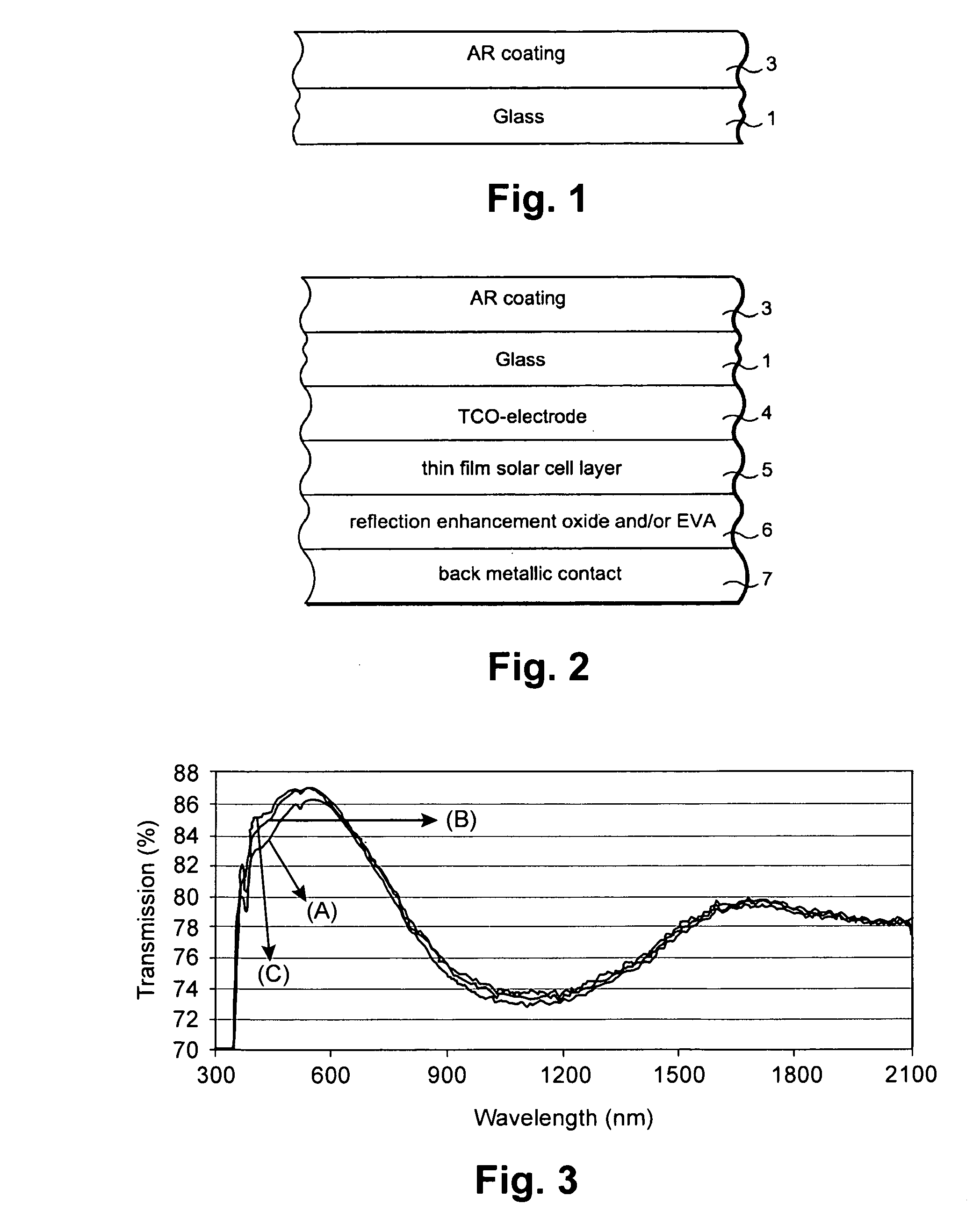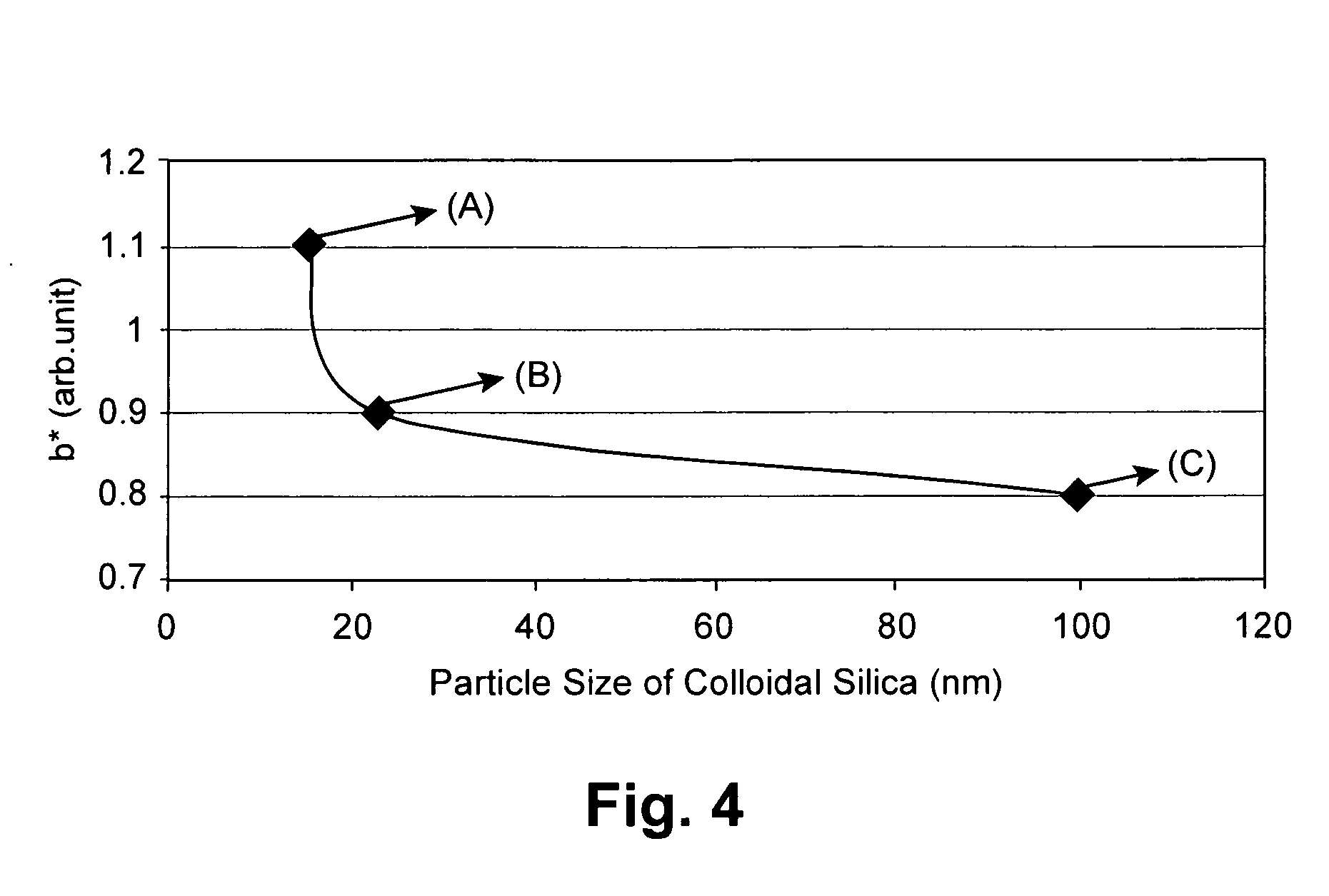Coated article comprising colloidal silica inclusive anti-reflective coating, and method of making the same
a technology of anti-reflective coating and coated article, which is applied in the field of photovoltaic devices, can solve the problems of less efficient solar cell, and achieve the effects of increasing radiation, less efficient solar cell, and reducing the amount of radiation
- Summary
- Abstract
- Description
- Claims
- Application Information
AI Technical Summary
Benefits of technology
Problems solved by technology
Method used
Image
Examples
example 1
[0038]The silica sol for Example 1 was prepared as follows. A polymeric component of silica was prepared using 64% by wt. of n-propanol, 24% by wt. of Glycydoxylpropyltrimethoxysilane (Glymo), 7% by wt. of water, and 5% by wt. of hydrochloric acid. These ingredients were mixed for 24 hours. The coating solution was prepared by using 21% by wt. of polymeric solution, 7% by wt. colloidal silica in methyl ethyl ketone (MEK-ST) with 15 nm particle size particles supplied by Nissan Chemicals Inc., and 72% by wt. n-propanol. This solution was stirred for 2 hours to provide a silica sol (also sometimes referred to herein as “the final solution”). The silica coating was fabricated using a spin coater operating at 1200 rpm for 30 sec. The coating was heated on a hot plate at 150 degrees C. for 2 minutes, then in an oven at 220 degrees C. for 2.5 minutes, and tempered in a furnace at 625 degrees C. for 3.5 minutes. The thickness of the coating was approximately 128.9 nm, and the transmission ...
example 2
[0039]The silica sol for Example 2 was prepared as follows. A polymeric component of silica was prepared using 64% by wt. of n-propanol, 24% by wt. of Glycydoxylpropyltrimethoxysilane (Glymo), 7% by wt. of water, and 5% by wt. of hydrochloric acid. These ingredients were mixed for 24 hours. The coating solution was prepared by using 21% by wt. of polymeric solution, 7% by wt. colloidal silica in methyl ethyl ketone (MEK-ST-MS) with 25 nm particle size particles supplied by Nissan Chemicals Inc., and 72% by wt. n-propanol. This solution was stirred for 2 hours to provide a silica sol (also sometimes referred to herein as “the final solution”). The silica coating was fabricated using a spin coater operating at 1450 rpm for 30 sec. The coating was heated on a hot plate at 150 degrees C. for 2 minutes, then in an oven at 220 degrees C. for 2.5 minutes, and tempered in a furnace at 625 degrees C. for 3.5 minutes. The thickness of the coating was approximately 133.5 nm, and the transmissi...
example 3
[0040]The silica sol for Example 3 was prepared as follows. A polymeric component of silica was prepared using 64% by wt. of n-propanol, 24% by wt. of Glycydoxylpropyltrimethoxysilane (Glymo), 7% by wt. of water, and 5% by wt. of hydrochloric acid. These ingredients were mixed for 24 hours. The coating solution was prepared by using 21% by wt. of polymeric solution, 7% by wt. colloidal silica in methyl ethyl ketone (MEK-ST-U) with 100 nm particle size particles supplied by Nissan Chemicals Inc., and 72% by wt. n-propanol. This solution was stirred for 2 hours to provide a silica sol (also sometimes referred to herein as “the final solution”). The silica coating was fabricated using a spin coater operating at 1000 rpm for 30 sec. The coating was heated on a hot plate at 150 degrees C. for 2 minutes, then in an oven at 220 degrees C. for 2.5 minutes, and tempered in a furnace at 625 degrees C. for 3.5 minutes. The thickness of the coating was approximately 130 nm, and the transmission...
PUM
| Property | Measurement | Unit |
|---|---|---|
| particle size | aaaaa | aaaaa |
| particle size | aaaaa | aaaaa |
| thickness | aaaaa | aaaaa |
Abstract
Description
Claims
Application Information
 Login to View More
Login to View More - R&D
- Intellectual Property
- Life Sciences
- Materials
- Tech Scout
- Unparalleled Data Quality
- Higher Quality Content
- 60% Fewer Hallucinations
Browse by: Latest US Patents, China's latest patents, Technical Efficacy Thesaurus, Application Domain, Technology Topic, Popular Technical Reports.
© 2025 PatSnap. All rights reserved.Legal|Privacy policy|Modern Slavery Act Transparency Statement|Sitemap|About US| Contact US: help@patsnap.com



